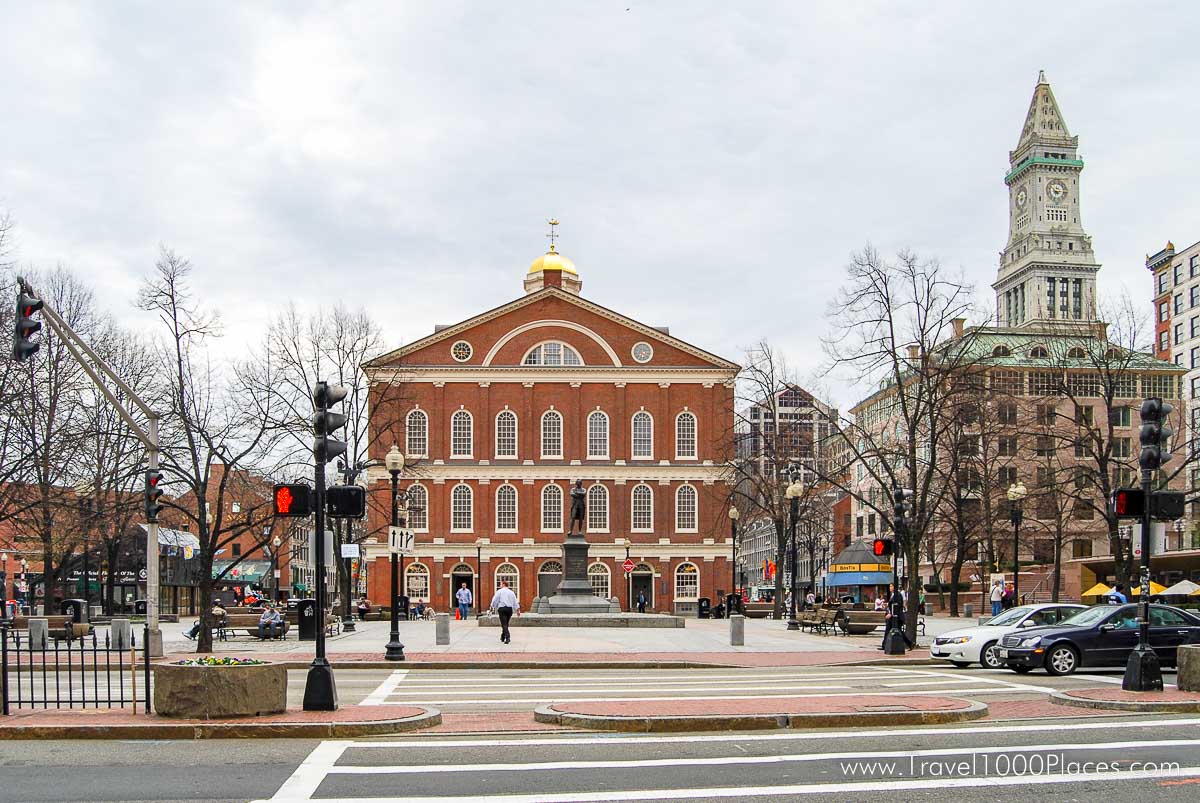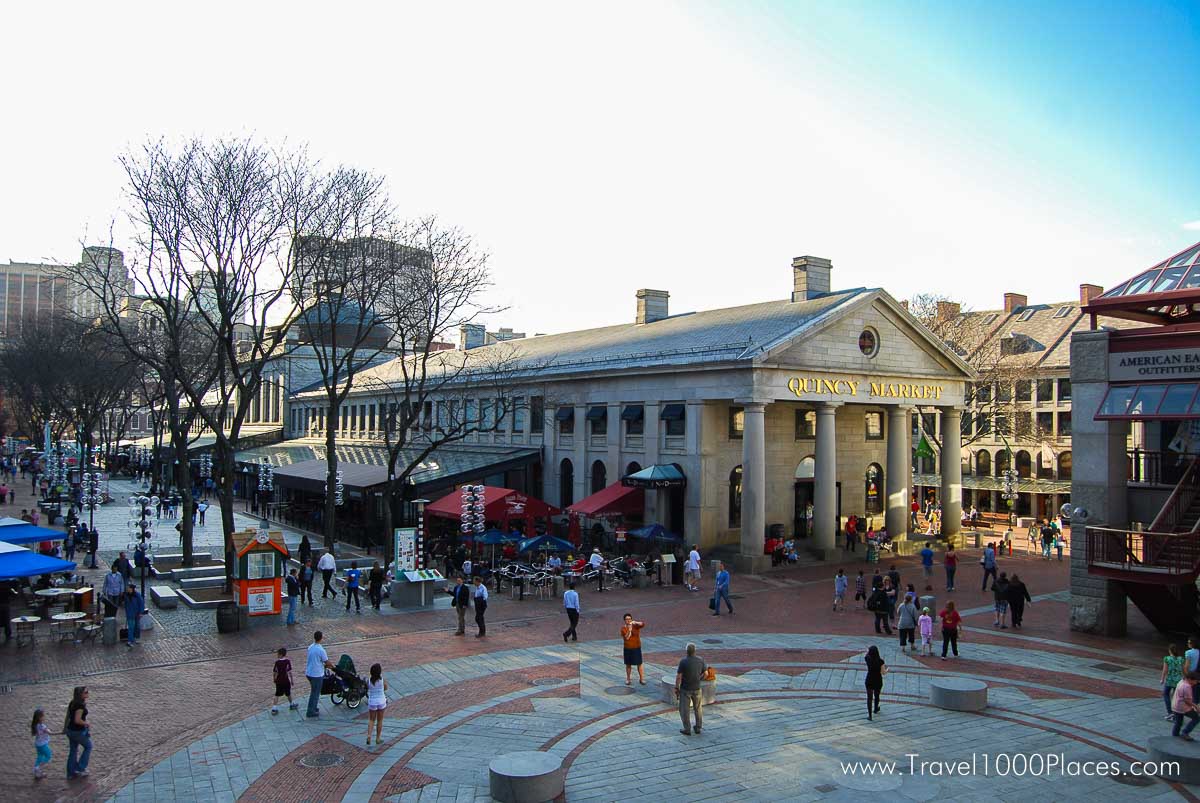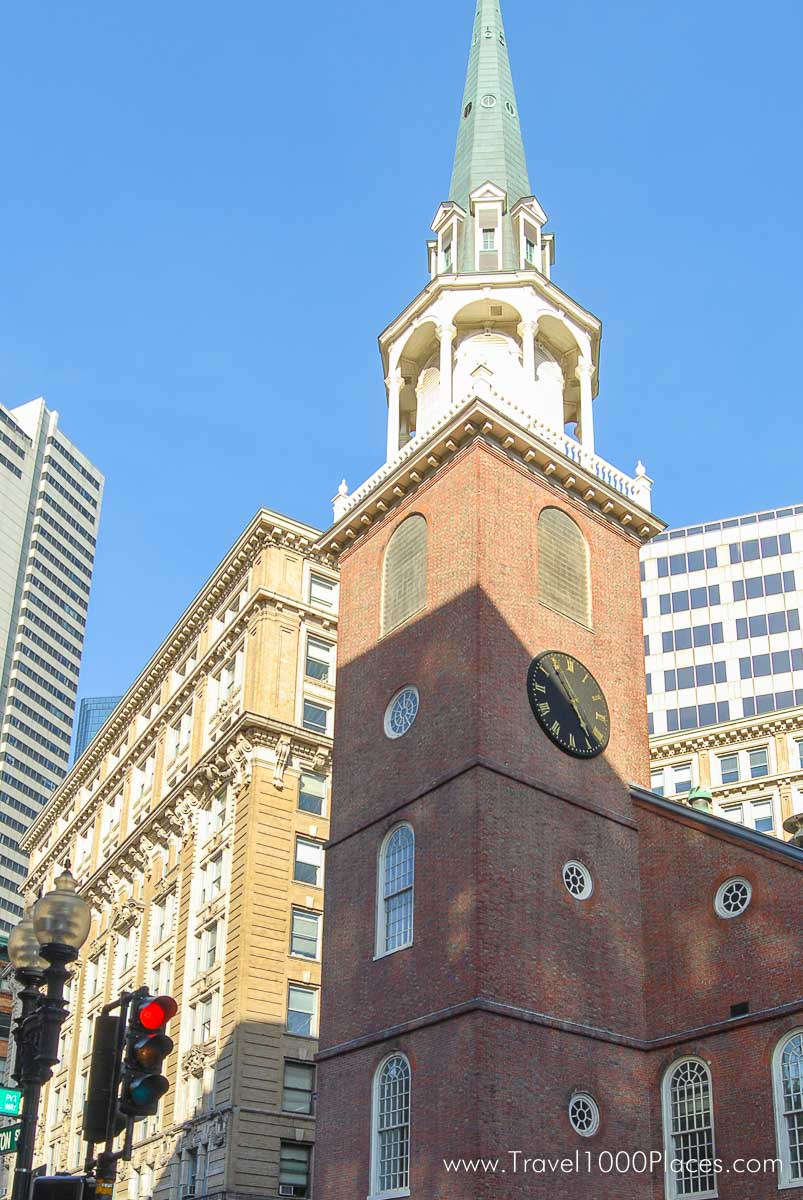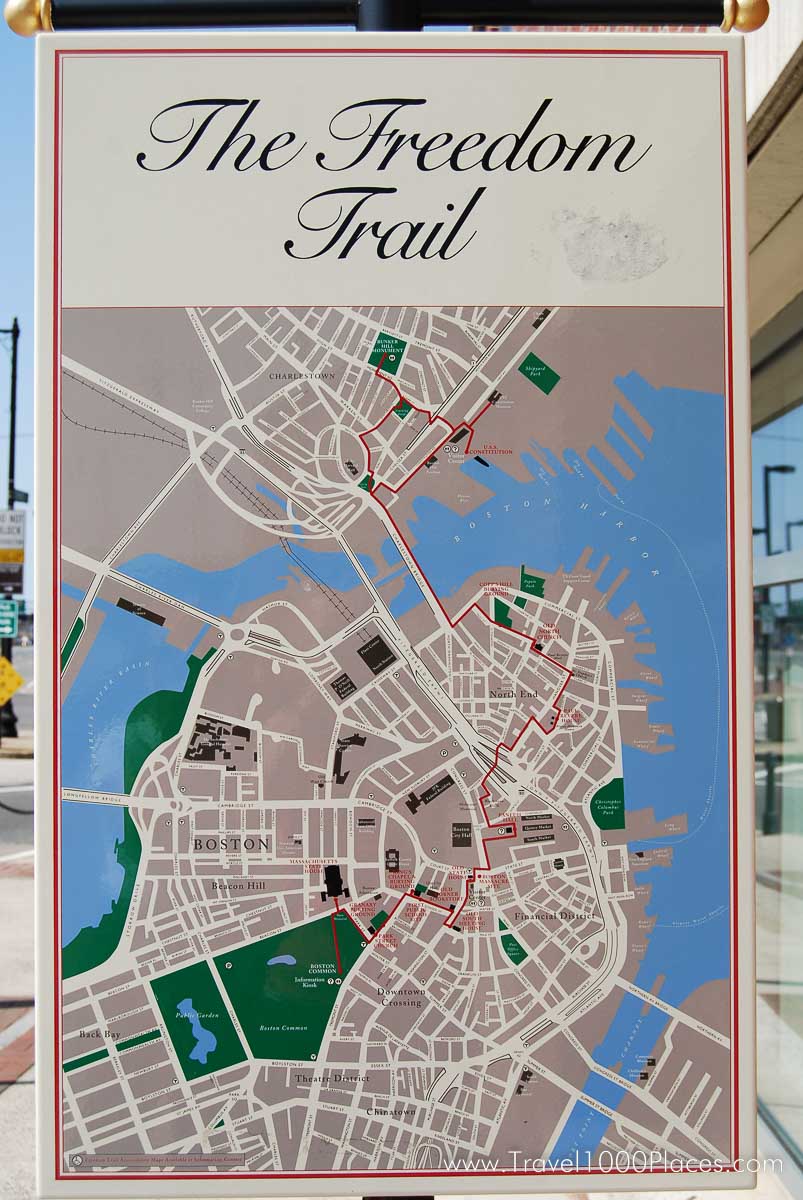

Read more about Boston like Overview, Weather, Airport, Transportation, Essentials in Boston, Massachusetts, USA — Overview for travelers
Sightseeing & Attractions
- Faneuil Hall Marketplace & Quincy Market Building
- Old State House
- Old South Meeting House
- Black Heritage Trail
- The Freedom Trail
- USS Constitution
- Paul Revere House
- New England Aquarium
- Longfellow National Historic Site
- Beacon Hill
- Back Bay
- South End
- Boston’s Fall Foliage
Faneuil Hall Marketplace & Quincy Market Building
This market building, first built in 1742, sits at the site of the old town dock. Town meetings, held here between 1764 and 1774, heard Samuel Adams and others lead cries of protest against the imposition of taxes on the colonies. The building was enlarged in 1806.
Frederick Douglass, William Lloyd Garrison, a nd Lucy Stone brought their struggles for freedom here in the 19th century. The Market stalls on the first floor of Faneuil Hall service shoppers much as they did in Paul Revere’s day. Housed in 3
Beautifully restored 19th century buildings, its 125 shops& 21 restaurants offer tantalizing delicacies and unique gifts in a festive atmosphere that spills onto cobblestone streets filled with an amazing variety of street performers.
An eclectic experience with something for everyone.
Web: Downtown Sites – Boston National Historical Park (U.S. National Park Service) (nps.gov)
Old State House
Founded in 1881 to save the Old State House from being moved to Chicago, The Bostonian Society is the historical society for the city of Boston.
Through library and museum collections which date from the 1630s to the twentieth century, with exhibitions on the American Revolution and Boston’s neighborhoods, and through programs for adults and children, the Society brings Boston history to life.
The Bostonian Society is the first stop for anyone interested in the city’s history. With a museum within the 1713 Old State House, a research library and programs and events for all ages, the Society provides a comprehensive resource.
206 Washington Street
Web: Downtown Sites – Boston National Historical Park (U.S. National Park Service) (nps.gov)
Old South Meeting House

This decision on Dec. 15, 1773 when 5,000 angry colonists gathered at the Old South Meeting House to protest a tax started a revolution with the Boston Tea Party.
As a meeting place and a haven for free speech and assembly, the Old South Meeting House has been in continuous use for over 250 years.
Visit this National Historic Landmark and experience events that shaped our country.
Become engaged through our multi-media exhibit “Voices of Protest” which tells the story often inspiring, sometimes disturbing, frequently controversial and always facinating…of the Old South Meeting House and the people who have spoken here.
Address: 310 Washington St.
Web: Downtown Sites – Boston National Historical Park (U.S. National Park Service) (nps.gov)
Black Heritage Trail
![Boston's Black Heritage Trail [image: NPS]](https://www.travel1000places.com/wp-content/uploads/2022/06/nps-black-heritage-trail-map.jpg)
The Black Heritage Trail® is a 1.6 mile walk through the heart of Boston’s Beacon Hill neighborhood. The trail showcases residences and community buildings associated with a Black community that thrived on, and near, the north slope of Beacon Hill before, during, and after the American Civil War. Throughout that time, this community struggled and organized for equal rights and access to equal education. Community members championed the movement to abolish slavery and even housed freedom seekers on their journey along the Underground Railroad.
Most sites along the trail remain private residences. However, the final stops—the Abiel Smith School and the African Meeting House—are part of the Museum of African American History which is open to the public.
For a full audio tour of the The Black Heritage Trail®, check out the Self Guided Tour in the NPS App.
Web: Walk the Black Heritage Trail® (U.S. National Park Service) (nps.gov)
The Freedom Trail
![Boston's Freedom Trail Map [image: NPS]](https://www.travel1000places.com/wp-content/uploads/2022/06/nps-boston-freedom-trail-map.jpg)

The Freedom Trail is 2.5 miles long (Boston Common to Bunker Hill) and is marked by a red brick line on the sidewalk. Visitors can choose any site as a starting point. Best explored by foot, the Freedom Trail can be walked non-stop in one hour.
Allow a minimum of 3 hours to leisurely stroll the trail, and a full day to explore each and every site. Wear comfortable clothes and walking shoes.
Originally conceptualized in the 1950s, the Freedom Trail® is an iconic symbol of Boston. Its red brick line snakes through some of the oldest parts of the City, navigating visitors to some of the most significant historic sites in the Downtown, North End, and Charlestown neighborhoods of Boston. The trail itself does not necessarily tell a narrative. Rather, it aids tourists with a starting point—an opening sampler of Boston’s storied, complicated, and multi-faceted history. While many sites are primarily recognized for their role in the American Revolution, all the sites on the Freedom Trail® remained significant because of the role they played in subsequent social, political, and religious movements, controversies, and challenges.
Use the map and the list below to explore each site in any order you please. The sites and content can be used as a completely virtual tour. Or, you may use our Freedom Trail audio tour as you explore this trail of historic sites. Download the NPS App and search “Boston National Historical Park” to access the self-guided Freedom Trail audio tour.
The Freedom Trail is composed of the following
independently operated 16 sites:
Boston Common
The State House
Park Street Church
Granary Burying Ground
King’s Chapel
King’s Chapel Burying Ground
Site of the First Public School
Old South Meeting House
Old Corner Bookstore
Old State House
Boston Massacre Site
Faneuil Hall
Paul Revere House
Old North Church
Copps Hill Burying Ground
USS Constitution
Bunker Hill Monument
Web: Walk the Freedom Trail (U.S. National Park Service) (nps.gov)
Web: Virtual Freedom Trail Tour – Boston National Historical Park (U.S. National Park Service) (nps.gov)
USS Constitution
…the oldest commissioned warship afloat in the world!
Climb aboard the Mayflower and re-live the pilgrim’s death-defying journey to the New World. Explore the decks of the USS Constitution and learn why sailors dubbed her “Old Ironsides.” See where the Salem witches were hanged.
Experience everday life in an 1830’s New England village. Travel back in time for history you can see and touch!
Address: 1 Constitution Rd.
Charlestown
Web: Charlestown Navy Yard – Boston National Historical Park (U.S. National Park Service) (nps.gov)
USS Constitution > United States Navy – Fact Files (navy.mil)
Paul Revere House
Home to the famed patriot Paul Revere the Paul Revere Memorial Association owns and operates the Paul Revere House and the Pierce-Hichborn House, located on the Freedom Trail’s North End.
The Paul Revere House presents living history performances, concerts, craft demonstrations and more at the home of the famous patriot and silversmith, Paul Revere.
Address: 19 North St. Boston
New England Aquarium
Two thousand species of exotic fish, sharks, and sea turtles in giant ocean tank; penguin colony; hands-on tidepool exhibit; seal and sea otter tanks; IMAX Theatre. Exotic fish species, sharks, sea turtles, and moray reels in the Giant Ocean Tank. Penguins, seals, sea otters, a hands-on tide pool, and IMAX theatre.
Address: Central Wharf, Boston
Web: Home – New England Aquarium (neaq.org)
Longfellow National Historic Site
Longfellow National Historic Site is an outstanding example of a historic site representing the themes of arts and literature.
For almost half a century (1837-1882) this was the home of one of the world’s foremost poets, scholars and educators, Henry Wadsworth Longfellow.
Longfellow House is also significant in America’s colonial history.
General George Washington, Commander-in-Chief of the newly-formed Continental Army, headquartered and planned the Siege of Boston here between July, 1775 and April, 1776.
Noteworthy Neighborhoods
Beacon Hill
The beacon on this hill that used to warn settlers about foreign invasions is long gone, and today Beacon Hill is a close-knit community in a downtown location.
The neighborhood’s cobblestone streets and brick rowhouses directly border the Boston Common and the Public Garden, American’s first botanical garden.
The gold leaf of the State House Rotunda adorns the hill and shines across the Common.
A great place for families, this historic neighborhood is a blend of classic Boston architecture and expansive green space]
Boston’s first resident, Reverend William Blaxton, lived alone on Beacon Hill for 5 years before settlers arrived in 1622.
Now this neighborhood is home to over 10,000 people.
Back Bay
The Back Bay, once a stagnant pool of water behind the Public Garden, now holds some of the most exclusive real estate in Boston.
A stroll down Newbury St. will take you from high fashion to hip ice cream parlors, and a walk back up Commonwealth Ave. will let you take in some of the most elegant townhouses in the city.
With its rows of historic homes and a vibrant commercial district to boot, Back Bay is an elegant and exciting place to live.
South End
The South End, with its blocks of Victorian brick row houses, upscale restaurants, and art galleries, is swiftly becoming one of the most popular places to live in Boston.
Many of the row houses underwent renovation starting in the 1960s, and today the neighborhood is filled with a diverse mix of families, young professionals, a gay and lesbian community and a thriving artistic center.
Trendy restaurants brush shoulders with coffeshops and Mom & Pop grocery stores along Tremont Street and its side streets all the way down to Washington Street ,
which is experiencing an artistic revival, a significant number of artists are moving in,
and galleries are cropping up around the area to show their works.
Boston’s Fall Foliage
Arnold Arboretum
Boston’s outdoor ‘tree museum’ is a 130-year-old free 265-acre park featuring more than 14,000 varieties of trees and shrubs, guaranteeing that you will see plenty of brightly-colored fall leaves.
Trees are labeled by the professional staff of Harvard University, which administers the arboretum.
The grounds are open daily from dawn until dusk .
The Charles River in Boston & Cambridge offers tree-lined parks along its banks, walking, bicycling trails ,a 17-mile Dr. White Bikeway Loop is a wonderful way to enjoy the foliage and the boathouses along the riverside. The riverfront paths are open daily from dawn until dusk. Easy walk from most hotels.
The Fens and the Riverway
in Boston and Brookline are both tree-lined walk-and-bikeways, they are part of the ‘Emerald Necklace’ that begins in downtown Boston with America’s first park (1634) the Boston Common, continues through the first botanical garden ‘The Public Garden’, along the tree-lined Commonwealth Mall that brings visitors to the Fens and the Riverway.
The Fens and the Riverway are the front yards for the Boston Museum of Fine Arts, the 100-year-old Isabella Stewart Gardner Museum, Simmons College, and Wheelock College.
The Fens and Riverway are open daily from dawn until dusk.

